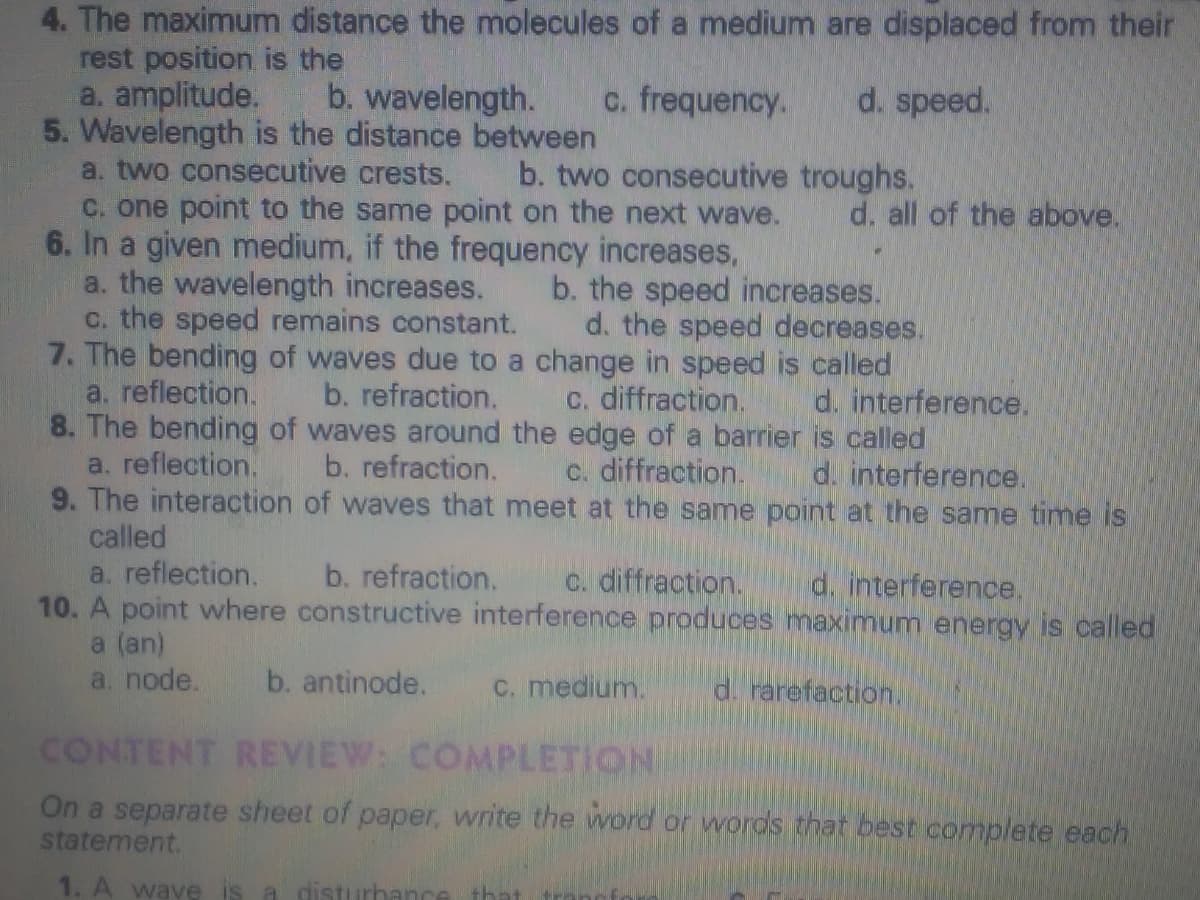4. The maximum distance the molecules of a medium are displaced from their rest position is the a. amplitude. 5. Wavelength is the distance between a. two consecutive crests. C. one point to the same point on the next wave. 6. In a given medium, if the frequency increases, a. the wavelength increases. c. the speed remains constant. 7. The bending of waves due to a change in speed is called a. reflection. 8. The bending of waves around the edge of a barrier is called a. reflection. 9. The interaction of waves that meet at the same point at the same time is called a. reflection. 10. A point where constructive interference produces maximum energy is called a (an) b. wavelength. c. frequency. d. speed. b. two consecutive troughs. d. all of the above. b. the speed increases. d. the speed decreases. b. refraction. C. diffraction. d. interference. b. refraction. c. diffraction. d. interference. b. refraction. C. diffraction. d. interference.
4. The maximum distance the molecules of a medium are displaced from their rest position is the a. amplitude. 5. Wavelength is the distance between a. two consecutive crests. C. one point to the same point on the next wave. 6. In a given medium, if the frequency increases, a. the wavelength increases. c. the speed remains constant. 7. The bending of waves due to a change in speed is called a. reflection. 8. The bending of waves around the edge of a barrier is called a. reflection. 9. The interaction of waves that meet at the same point at the same time is called a. reflection. 10. A point where constructive interference produces maximum energy is called a (an) b. wavelength. c. frequency. d. speed. b. two consecutive troughs. d. all of the above. b. the speed increases. d. the speed decreases. b. refraction. C. diffraction. d. interference. b. refraction. c. diffraction. d. interference. b. refraction. C. diffraction. d. interference.
Physics for Scientists and Engineers, Technology Update (No access codes included)
9th Edition
ISBN:9781305116399
Author:Raymond A. Serway, John W. Jewett
Publisher:Raymond A. Serway, John W. Jewett
Chapter17: Sound Waves
Section: Chapter Questions
Problem 17.65AP: A police car is traveling east at 40.0 m/s along a straight road, overtaking a car ahead of it...
Related questions
Question

Transcribed Image Text:4. The maximum distance the molecules of a medium are displaced from their
rest position is the
a. amplitude.
5. Wavelength is the distance between
a. two consecutive crests.
C. one point to the same point on the next wave.
6. In a given medium, if the frequency increases,
a. the wavelength increases.
c. the speed remains constant.
7. The bending of waves due to a change in speed is called
a. reflection.
8. The bending of waves around the edge of a barrier is called
a. reflection.
9. The interaction of waves that meet at the same point at the same time is
called
b. wavelength.
c. frequency.
d. speed.
b. two consecutive troughs.
d. all of the above.
b. the speed increases.
d. the speed decreases.
b. refraction.
C. diffraction.
d. interference.
b. refraction.
c. diffraction.
d. interference.
a. reflection.
10. A point where constructive interference produces maximum energy is called
a (an)
a. node.
b. refraction.
C. diffraction.
d. interference.
b. antinode.
C. medium.
d. rarefaction.
CONTENT REVIEW: COMPLETION
On a separate sheet of paper, write the word or words that best complete each
statement.
1. A wave is a disturhar
Expert Solution
This question has been solved!
Explore an expertly crafted, step-by-step solution for a thorough understanding of key concepts.
This is a popular solution!
Trending now
This is a popular solution!
Step by step
Solved in 2 steps

Knowledge Booster
Learn more about
Need a deep-dive on the concept behind this application? Look no further. Learn more about this topic, physics and related others by exploring similar questions and additional content below.Recommended textbooks for you

Physics for Scientists and Engineers, Technology …
Physics
ISBN:
9781305116399
Author:
Raymond A. Serway, John W. Jewett
Publisher:
Cengage Learning

College Physics
Physics
ISBN:
9781285737027
Author:
Raymond A. Serway, Chris Vuille
Publisher:
Cengage Learning

College Physics
Physics
ISBN:
9781305952300
Author:
Raymond A. Serway, Chris Vuille
Publisher:
Cengage Learning

Physics for Scientists and Engineers, Technology …
Physics
ISBN:
9781305116399
Author:
Raymond A. Serway, John W. Jewett
Publisher:
Cengage Learning

College Physics
Physics
ISBN:
9781285737027
Author:
Raymond A. Serway, Chris Vuille
Publisher:
Cengage Learning

College Physics
Physics
ISBN:
9781305952300
Author:
Raymond A. Serway, Chris Vuille
Publisher:
Cengage Learning

Physics for Scientists and Engineers
Physics
ISBN:
9781337553278
Author:
Raymond A. Serway, John W. Jewett
Publisher:
Cengage Learning

Physics for Scientists and Engineers with Modern …
Physics
ISBN:
9781337553292
Author:
Raymond A. Serway, John W. Jewett
Publisher:
Cengage Learning
